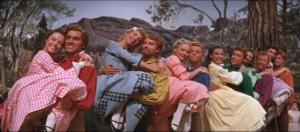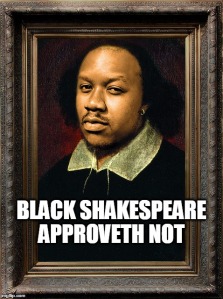Sometimes it seems like our whole entire culture is one huge celebration of thin white women. Ogling them, collecting them, advertising products to help other women become more like them, giving them all the awards for everything ever. It’s not just that the pinnacle of American womanhood is seen as thin and white (and cis, and able-bodied). It’s that thin white women are framed as “normal,” “neutral,” and every other woman is measured by her distance from that “norm.” “Black woman,” “transwoman,” “plus-size woman.”
Maybe this is changing, maybe not. Like you, I live on the internet, where one can find pictures of all types of women, from professional shots to vacation snaps, and plus-size (I know, I know, bear with me) women are everywhere. There are plus-size models (both professional and indie, some with huge followings), fashion bloggers (also with huge followings), sex bloggers, singers in various genres, photographers who specialize in gorgeous shots of plus-size people, and, of course, a handful of famous plus-size actors cast in film and television roles. The body positivity movement is extremely popular, and has a significant presence on every social media platform and the internet in general, where it promotes self-acceptance and stands against the shaming, bullying, and body policing with which women (and some men) are victimized every day, as well as the tsunami of relentless backlash the movement itself faces.
Nothing brings out the angry, outraged commenters faster than a picture of a woman who’s not rail-thin.
Humans LOVE bigotry. We LOVE grouping together in “us” vs. “them” to shame, disparage, and belittle “them,” shoring up our “us” identity and placating our own insecurities and self-doubts. This makes us feel like we’re part of something larger, something strong, something, above all, superior. This is an intense human impulse that is expressed in things as damaging as racism and as benign as choosing a sports team. When we claim membership to a group, along with that comes shaming, disparaging, and belittling people who are not in that group, either good-naturedly when we have no real power over “them” (“Dodgers suck”) or with devastating consequences when we do. Every single group that ever existed has a list of “known,” “true,” or even “scientifically proven” reasons that people outside their group deserve disparagement. Science has been used to confirm literally every racial bias the west has ever had.
Science only gets answers to the questions it asks. The cultural biases of researchers very often generate results that confirm those biases. Biases lead researchers to create studies or aggregate data in ways that are designed to produce results that confirm their biases. Science understands this and attempts to correct for it with things like double-blind studies and peer review, which are all, of course, still deeply influenced by the culture.
Don’t get me wrong– I’m very pro-science. But I’m also realistic. The well-known cultural trope of “overweight = unhealthy” is being problematized in study after study (after study), while other studies confirm it (as relentlessly reported in every corner of the media). Which studies are “true”? The ones that confirm your pre-existing biases, of course. The rest are “junk science.”

Marie Denee, founder and editor of The Curvy Fashionista– curvyfashionista.com. (source: Glamour.com)
There’s an enormous amount of conflicting information about what an “ideal” weight is (the ranges were ratcheted lower several times in the 20th century), how people become overweight, lose weight, or maintain weight loss, yet our culture “knows” that overweight people are that way through choice, laziness, gluttony, lack of self-control, or even a lack of moral fiber, thereby excusing and even lauding the bigotry against fat people.
When an image of a woman who is not rail-thin is publicly displayed in any context other than one specifically discussing her weight in a negative light, even if the context has nothing whatsoever to do with weight, people go out of their way to make disparaging comments. The comments fall into two main categories: insults/slurs, and some version of “I’m just concerned about [this total stranger’s] health”/”this promotes an unhealthy lifestyle.”
You can’t determine the health of an individual by looking at a picture. If you look at a picture of a fat person and think, “they’re unhealthy,” you’re engaged in an act of bigotry stemming from cultural bias, not making a medically sound diagnosis. And if you’re not posting similar comments on images of high heels, MMA and boxing, bacon, or other well-known public health concerns, then you are a concern troll: someone who uses “concern” as a cover for shaming, belittling, and bullying.
Someone cannot “promote” any kind of lifestyle simply by existing. Yet I’ve seen– we’ve all seen– “this is promoting an unhealthy lifestyle” comments on shampoo ads, fashion photography, celebrity profiles, and even photos of fat women working out.

The August 2015 cover of Women’s Running featured model and runner Erica Schenk, drawing both widespread praise and criticism. (James Farrell, WomensRunning.com)
And let’s pause for a moment and remember that this issue is intersectional, and that larger women of color are the targets of unfathomable bigotry and hostility. Most people don’t even bother to cover their bigotry with “concern” like they do for white women.
We’re in a cultural moment where people are pushing back against thin privilege, and are being met with culturally-approved, flat-out HATRED. As content creators in the entertainment industry, who impact culture more than any other single source, we need to work against this hatred.
We stand up for gender parity, yet the only women our industry feels are worthy of inclusion are thin ones, or women like Robyn Lawley, whose “plus size” (at 6’2″) is 12. We need to stand up for the inclusion of ALL women, which includes stepping away from the constant, constant focus on women who only fit a certain body type unless the script explicitly calls for it. The adamant defense of thin privilege throughout our industries has got to stop, and the only way to get there is to make a conscious decision to stop it. This is our choice to make, and we must make it.

Robyn Lawley is considered a “plus size model,” the first to be featured in Sports Illustrated. Photo: James Macari/si.com
We need to be realistic about the ways our current fight for gender parity often ignores intersectionality. Here in the Bay Area, there’s been some discussion about adding a marker to theatre listings that indicates which shows have gender parity (cast, crew, and playwright) so people can support them. This ignores a raft of crucial issues. A show about four thin, white, wealthy women would be starred and therefore recommended and publicly congratulated, yet a show devised and performed by four young Black men speaking the truths about their lives would not.
Of course many (perhaps most) people fighting for gender parity are also fighting for greater racial diversity, but I’ve personally seen industry professionals say things like, “Gender is a more important issue than race, which is basically just a look.” I’ve seen multiple times: “We have to cast beautiful women because actors have to be desirable objects for the audience,” which begs the question: What is “beautiful?” Because I will bet the farm that means thin, white, able-bodied, and cis.
Yet WE CONTROL what “beautiful” is. We change the definition of beauty by creating cultural content. We’ve done it over and over and over, from Gibson Girls to Clara Bow to Marilyn Monroe to Farrah Fawcett to Scarlett Johansson. This is our choice to make.
There’s no reason we can’t open our definition of “beautiful” to include more diversity– more intersectional diversity that better reflects the women in this country– the people who are buying most of the film and theatre tickets. But first we must open our definition of “woman” to include more intersectional diversity, and cast women who aren’t thin, white, cis, AND able-bodied, because right now, you need all four to be considered “right” for the role of “woman.” If you’re missing even just one of those, you’re only “right” for “Black woman,” “overweight woman,” or “disabled woman.” This is our responsibility to change.

Fashion blogger Stacey from Hantise de L’oubli. One of my personal favorites. Her instagram is @hantisedeloubli. Photo: hantisedeloubli.com
If we’re going to push theatre and film companies for gender parity, let’s make sure we don’t enable yet another cultural space that celebrates thin, white, cis, able-bodied women and ignores (at best) everyone else.







